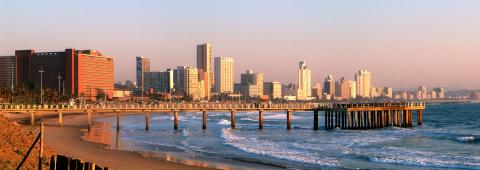Durban, South Africa - Empowering Street Traders Through Urban Disaster Risk Management

Durban, South Africa. © UN-Habitat
The east coast city of Durban is South Africa’s third largest city with a population of about 3.5 million. Durban is a commercial and transport hub, and has the busiest port in Africa. Since the decline of key manufacturing industries in Durban, informal employment in the municipality, renamed eThekwini in 2000, has been increasing. According to city government estimates, a third of economically active adults worked in the informal sector in the late 1990s and growth in this sector was far outpacing that of the formal sector. Durban initially responded positively toward this growth in informal workers, implementing progressive legislation, although more recent changes in the municipality’s approach to informal workers, especially street vendors and market traders, have seen a breakdown in integrating them into urban plans.
“Small-scale operations and the informal sector are important sources of employment and innovation.”
- Nomvuzo Shabalala, Deputy Mayor of eThekwini Municipality.
In 2014, Women in Informal Employment: Globalizing and Organizing (WIEGO) and Asiye eTafuleni (AeT) launched a pilot project, the Phephanathi Project (“phephanathi” means “be safe with us” in isiZulu) aimed at empowering informal traders to be part of city planning through participatory disaster risk management. The intent was to collaborate with city officials and thereby build a foundation to develop a more resilient city for all.
The 6,000 – 8,000 traders in Warwick Junction, a sprawling informal market complex in the heart of Durban, provide essential goods and services to the city —food, haircuts, clothing and household goods — at affordable rates. Yet the market also poses many health and safety hazards to both traders and visitors. Fires are one of the main concerns, since many traders use open- flame cooking stoves to prepare food for their stalls.
The Phephanathi Project started by forming risk-management sub-committees to raise awareness and monitor health and safety issues in the markets. Sub-committee members conducted a participatory digital mapping exercise of fire hazards in one of the Warwick Junction markets. This first phase successfully brought together municipal representatives and traders. Vendors and traders along with staff from the eThekwini Metro Fire Department and the Provincial Disaster Management Department developed a digital map of hazardous areas by marking the points using GPS. They found many issues, such as gas canisters being stored inappropriately and blocked fire exits. The Metro Fire Department officials also tested existing fire equipment, and provided fire safety lessons about cooking with gas.
The next phase of the Phephanathi Project focused on responding to the health and safety needs of the market by installing prototype first aid stands (now referred to as “green crosses” by the traders) and sand-filled fire cones. Prior to rolling out the stands into the market, the WIEGO and AeT team undertook a detailed siting exercise with the help of traders in each market. During this exercise, the number and placing of the stands in each market was decided upon together. Measurements were also taken to ensure that the stands could be tethered to appropriate infrastructure (trader tables, poles, etc.) that suited everyone’s needs.
“Resilient cities means resilient communities and resilient livelihoods. Those working in the informal economy in cities all around the world provide essential services like waste management, small-scale production for formal value chains, and affordable food retailing. They do so at very little cost to their cities or to the environment. Their work is the bedrock for resilient cities and they must be included in city planning processes.”
- Martha (Marty) Chen, Co-Founder and International Coordinator of WIEGO
The project also experimented with mapping of and experimentation with digital technologies to improve workplace health and safety. The two digital technologies, the Ushahidi Platform and Frontline SMS, used open- source data. The Ushahidi Platform was used to map information from multiple sources.
Frontline SMS is a web-based tool, which allows for sending and receiving of bulk SMS texts. Frontline was helpful in continually reminding traders of key safety measures and concerns, and an encouraging 93 per cent of traders reported that they had found the messages useful.
While the pilot phase has finished, the Phephanathi Project committee continues to meet, and the risk management sub-committees in each market have been charged with managing the first aid stands and the fire cones. The results of the hazard mapping will be added to additional hazard and infrastructure mapping sessions that have been carried out by AeT under different projects, and will be used as a basis for approaching local government about larger scale infrastructure upgrades in Warwick Junction. Most importantly, Warwick Junction traders have acquired skills and an understanding of urban development processes to create a safer work environment and more secure urban livelihoods.
